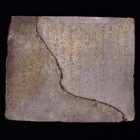Japanese Archaeology and Special Exhibition (Heiseikan) Japanese Archaeology Gallery
March 8, 2016 (Tue) - July 18, 2016 (Mon)
The creation of clay tablets with Buddhist sutras involves inscribing sutra text onto square or rectangular clay slabs and firing them. Created for about a century from the latter half of the 11th century, they have been found from over forty sutra mounds, many of which were located in western Japan.
Sutra mounds were built from around the end of the 10th century to preserve sutras following the spread of the belief in the decline of Buddhism (for details please see the exhibit Sutra Mounds: Time Capsules for 5,670,000,000 Years in this gallery). The common practice was to bury paper sutras stored in sutra cases and their outer containers together with various burial objects. However, paper sutras decompose over time, and, when discovered, have already lost their original forms in most cases.
Clay tablets, in contrast, tend to retain their original forms when buried. Tens or hundreds of them can be found in clusters from one site, which suggests clay tablets may have been invented to preserve sutras for a longer period of time. Clay tablets are extremely valuable as archaeological and textual materials because details of their production, such as methods, circumstances, and those who were involved, can be obtained from their forms and inscribed texts.
This exhibition showcases, in one sweep, prime examples of clay tablets and related objects that are in the museum collection or on long-term loan. Through these objects, visitors are invited to feel the earnest wishes of the people who lived, according to contemporary beliefs, during the time of Buddhism s decline.

